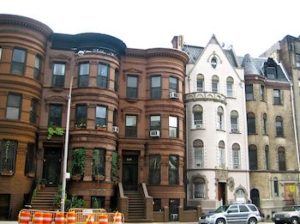
*Harlem, New York, is affirmed on this date in 1893.
Harlem is a neighborhood in the northern New York City borough of Manhattan. It is bounded roughly by Frederick Douglass Boulevard, St. Nicholas Avenue, and Morningside Park on the west; the Harlem River and 155th Street on the north; Fifth Avenue on the east; and Central Park North on the south.
This date was chosen to honor the birth of realtor Phillip Payton Jr., known as the "Father of Harlem." The greater Harlem area encompasses several other neighborhoods. It extends west to the Hudson River, north to 155th Street, east to the East River, and south to Martin Luther King, Jr., Boulevard, Central Park, and East 96th Street. Originally a Dutch village formally organized in 1658, it is named after the city of Haarlem in the Netherlands. Harlem's history has been defined by economic boom-and-bust cycles, with significant population shifts accompanying each cycle. Harlem was first a Jewish and Italian American community in the 19th century, but African Americans began to arrive in large numbers during the Great Migration in the 20th century.
In the 1920s and 1930s, Central and West Harlem was the focus of the "Harlem Renaissance," an outpouring of artistic work without precedent in the American Black community. Though Harlem musicians and writers are particularly well remembered, the community has also hosted numerous actors and theater companies, including the New Heritage Repertory Theater, National Black Theater, Lafayette Players, Harlem Suitcase Theater, The Negro Playwrights, American Negro Theater, and the Rose McClendon Players. The Apollo Theater opened on 125th Street on January 26, 1934, in a former burlesque house. The Savoy Ballroom on Lenox Avenue was a renowned venue for swing dancing and was immortalized in a popular song of the era, "Stompin' At the Savoy."
In the years between Lenox and Seventh Avenues in central Harlem, over 125 entertainment venues were in operation, including speakeasies, cellars, lounges, cafes, taverns, supper clubs, rib joints, theaters, dance halls, and bars and grills. 133rd Street, known as "Swing Street," became known for its lounges, speakeasies, and jazz scene during the Prohibition era and was dubbed "Jungle Alley" because of "inter-racial mingling" on the street. Some jazz venues, including the Cotton Club, where Duke Ellington played, and Connie's Inn, were restricted to whites only. Others were integrated, including the Renaissance Ballroom and the Savoy. 1936, Orson Welles produced his black Macbeth at the Lafayette Theater in Harlem. Grand theaters from the late 19th and early 20th centuries were torn down or converted to churches. Harlem lacked any permanent performance space until the creation of the Gatehouse Theater in an old Croton aqueduct building on 135th Street in 2006.
From 1965 until 2007, the community was home to the Harlem Boys Choir, a touring choir, and an education program for young boys, most of whom are Black. The Girls’ Choir of Harlem was founded in 1989 and closed with the Boys Choir. Harlem is also home to the largest African American Day Parade, which celebrates the culture of the African diaspora in America. The parade was started in the spring of 1969 with Congressman Adam Clayton Powell, Jr. as the Grand Marshal of the first celebration. Arthur Mitchell, a former New York City Ballet dancer, established Dance Theatre of Harlem as a school and company of classical ballet and theater training in the late 1960s. The company has toured nationally and internationally. Generations of theater artists have gotten a start at the school.
By the 2010s, new dining hotspots were opening in Harlem around Frederick Douglass Boulevard. At the same time, some residents fought back against the mighty waves of gentrification the neighborhood is experiencing. In 2013, residents staged a sidewalk sit-in to protest a five-days-a-week farmers market that would shut down Macombs Place at 150th Street. Central Harlem is part of Manhattan Community District 10. The 28th and 32nd Precincts of the New York City Police Department patrol it. The greater Harlem area includes Manhattan Community Districts 9 and 11 and several additional police precincts. Fire services are provided by four New York City Fire Department companies. Politically, Harlem is represented by the New York City Council's 7th, 8th, and 9th districts. The New York City Subway and local bus routes serve the area. It contains several public elementary, middle, and high schools and is close to several colleges, including Columbia University and the City College of New York.